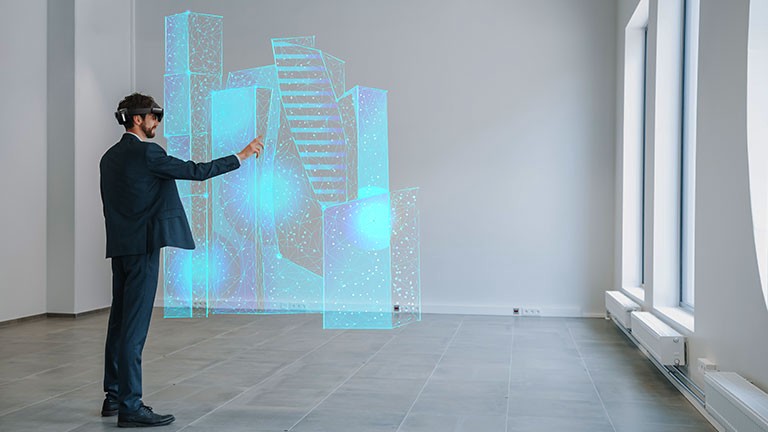
Train in VR, Work in AR: How Enterprises Are Closing the Skills Gap
The skills gap, changing Microsoft roadmaps, and multi-device realities are prompting leaders to modernise how people learn and perform.
The winning pattern is train‑to‑work: practice in VR (safe, repeatable, trainer‑independent) and execute in AR (step‑by‑step overlays + remote expert) on HMDs and mobiles. Studies show VR can compress learning time and boost confidence, while AR reduces errors and speeds complex manual work. PwC+1
Train in VR: Accelerate Time‑to‑Proficiency
Employees rehearse complex or infrequent jobs in VR until they can perform them consistently and safely—arriving on shift already fluent.
Outputs enterprises can achieve
- Faster onboarding (weeks → days for targeted roles) through repeatable, measurable VR reps.
- Accelerated workforce proficiency as new hires reach “confident‑independent” status sooner.
- No dependence on trainer or equipment—sessions run anytime without tying up SMEs or production assets.
- Muscle memory via digital twin—practice on a digital twin/high‑fidelity 3D model in a risk‑free virtual environment, so the real job feels familiar on day one.
Why it Works?
- Faster, more focused learning: VR learners complete training up to 4× faster than conventional training, with higher focus and confidence (per widely cited enterprise studies).
- Cost‑effective at scale: After content creation, VR delivers high‑rep practice without pulling assets off the line or coordinating instructor schedules.
- Custom Content: Use the same content without the need to rebuild it with site, line and plant-specific customizations.
Where to Apply First?
High‑consequence tasks (LOTO, commissioning), low‑frequency/high‑variability fixes, and roles with heavy new‑hire volume.
Work in AR: Make the Work Unmissable
On the floor, technicians follow in‑context, step‑by‑step instructions overlaid on the asset, escalate to a remote expert who can draw directly on their view, and capture evidence as they go.
Outputs enterprises can achieve
- Higher First‑Time‑Fix (FTFR) by pairing AR steps with instant expert escalation.
- Lower Mean-Time-To-Repair (MTTR) as crews resolve issues faster with precise visual guidance and co‑browsed manuals/parts.
- Fewer repeat truck rolls through remote resolution and better first‑visit parts accuracy.
- Preserved Tribal Knowledge with accessible captured videos (expert sessions, trainings and on-the-job resolution).
Why it Works?
- Lower cognitive load: Spatial callouts remove ambiguity (“which valve?”).
- Standardised execution: Step-by-step digital work instructions enforce the right sequence and proof‑of‑work.
- Instant expertise: Remote experts add precise, mixed‑reality annotations inside the workflow.
- Frictionless collaboration: Using your existing collaboration stack (e.g., Teams) reduces tool‑switching and governance headaches.
Where to Apply First?
Preventive maintenance and changeovers, complex repairs, line clearance/QA, safety‑critical isolations, and field service scenarios with repeat visits.
The Train‑to‑Work Concept
-
Author once, use twice: Build SOPs as granular steps with visuals/3D; reuse for VR practice and AR execution.
-
Practice to proficiency (VR): Reps on the digital twin build confidence and consistency.
-
Perform with guardrails (AR): Anchors, step-by-step digital work instructions and evidence capture keep quality high.
-
Escalate inside the workflow: One tap to a remote expert (e.g., a Teams call) with spatial annotations.
-
Measure & improve: Feed FTFR, MTTR, rework, time‑to‑competence into BI. Analyse and iterate steps that cause delays.
Altoura: A Door‑to-Floor Workforce Productivity Platform
- At the door (onboarding & upskilling): Altoura VR Training
Train new hires faster on a digital twin in a risk‑free virtual environment. Build muscle memory and accelerate proficiency without tying up trainers or equipment.
- On the floor (execution & support): Altoura Frontline
Frontline Procedures deliver step‑by‑step digital work instructions as AR overlays on the physical factory floor (anchors, gated checks, offline, analytics).
RemoteExpert helps crews troubleshoot faster with experts on a Teams call—mixed‑reality annotations, live video, webpage co‑browse, and session capture—across HoloLens, Quest, Android, iOS.
- Continuous proficiency (skills attainment): Offer refresher VR and AR training anytime to prevent skill drift and reinforce safety.
Why is this conversation urgent?
Your current tools have a runway.
Microsoft’s lifecycle announcement sets Dec 31, 2026 as the end of support for Guides and Remote Assist; HoloLens 2 is on a support track through 2027. Microsoft Learn+1
Altoura is Microsoft‑compatible and the only platform with native Teams integration. Migrate all D365 Guides content for free and run across HMDs and mobile so your workforce isn’t gated by a single device or roadmap.
You May Also Like
5 Ways AR Improve First‑Time‑Fix Rates
November 21 2025
Spatial Computing in The Digital Building Lifecycle
June 07 2021


.png?width=1366&height=768&name=Blog%20banner%203%20(1).png)
